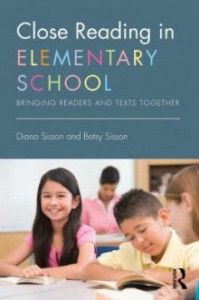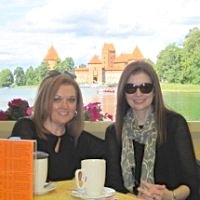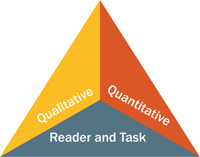Bring Close Reading, Writing & Talking Together
Close Reading in Elementary School: Bringing Readers and Texts Together
By Diana Sisson and Betsy Sisson
(Routledge/Eye on Education, 2014 – Learn more)

Close Reading in Elementary School: Bringing Readers and Texts Together by Diana Sisson and Betsy Sisson is like a box of crayons. Each bright chapter can stand alone but when put together, they all become a masterpiece.
The authors challenge teachers to practice what we ask our students to do–put on our “close reading glasses” to construct meaning from the text and understand what this means for today’s classroom.

According to an Education Week release, 1.3 million students drop out of school annually which translates to 7,000 students a day. (Swanson, 2010) The most common reason students cited was “their own perceived lack of literacy skills.” (p. 5) A similar study, Boiling Point: The Skills Gaps in U.S. Manufacturing, reported that over 600,000 jobs were open in the field, with 67 percent of respondents citing deficiencies in literacy skills as one of the contributing factors to not being hired (Deloitte, 2011).
With these staggering facts in mind and our own observations about trends in literacy, it is imperative that we continue to strengthen our students’ literacy skills to construct meaning from complex texts, in part by emphasizing close reading.
Why close reading?
I have found that in order to understand and appreciate trends in education, I need to ask myself the 5 Ws & H (Who, What, When, Where, Why, and How). Who will benefit from this change? What is the reason for the change? When did a need to change occur? Where will this change take my students? Why is it necessary to change? How can I take my current philosophy of teaching and curriculum to a higher standard? Close Reading in Elementary School is a book that answers these questions and more, recognizing the critical role of teachers in improving any aspect of our educational system.
What I found refreshing about this book were the persistent references to the importance of what we do every day in our classrooms. For example, as the authors explained the steps of close reading in chapter 3, “Overview of Close Reading Strategies,” they challenged the reader to ask what they want their students to gain from the experience. What is the purpose of the close read? How would you conduct the reading? They never let us forget that we are constantly making choices that determine whether and how much our students will learn.
Bring reading, writing and talking together
Diana and Betsy Sisson (they are sisters and both EdD’s) urge us to link close reading with close talks and close writes. Honestly, it makes sense. It’s like going up a ski lift. You don’t buy the special equipment, take the lessons, hop on the ski lift and then just stand 
You fly off that mountain, it’s exhilarating, and you are recharged to go again. After your experience, you might chat at the ski lodge with fellow skiers, gleaning from them ideas or places to try the next time you venture out on your skis, and maybe jot down some of the great ski jumps or successful techniques so you don’t forget.
Take the leap off the mountain with close reading. Push your students to engage in quality conversation, with “a distinct purpose in mind, carefully selected text(s) and constructed backward designed student questions. Close talks is an extension and deepening of critical thinking skills.” (p.135-6) The Sisson sisters are there by your side, providing interpretive, evaluative, clarifying and focusing question stems to scaffold student thinking.
Read this book closely

The Sissons
A word of advice as you read the book. Remember to “read closely” –and reread the text several times in order to analyze and gain a deep understanding of the text. Read the text through different eyes each time that you reread and increase your own rigor. Don’t forget that when an author writes a book, it is an invitation into an ongoing conversation. Ask questions. Invite comments. Note patterns. Challenge your thinking and the words of the authors. Have that conversation with your colleagues using the Book Study Reflective Question at the end of each chapter.
I have to warn you. If you want a book with one-size-fits-all prewritten lesson plans, this book is not for you. However, if you want a book that provides you with:
- a succinct history of close reading
- practical applications with an easy-to-use framework for creating a close reading lesson
- a valuable overview of the standards
an easy to understand model to assist in measuring text complexity
- suggestions on how to increase levels of rigor without destroying the love of learning
- ideas on how to link close reading with close talks and writes based on genre and student ability
- study guide questions to help you apply the strategies in the book to your individual classroom or to use in a book study group
…then this book is for you.
Linda Biondi is a fourth grade teacher at Pond Road Middle School in Robbinsville, NJ, and a long-time Morning Meeting practitioner. She’s also the recipient of several educational grants, a Teacher Consultant with the National Writing Project and a participant on the NJ Department of Education Teacher Advisory Panel. She recently shared her thoughts about the Common Core at the NJ SDE website.



































